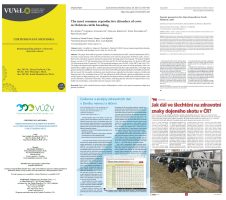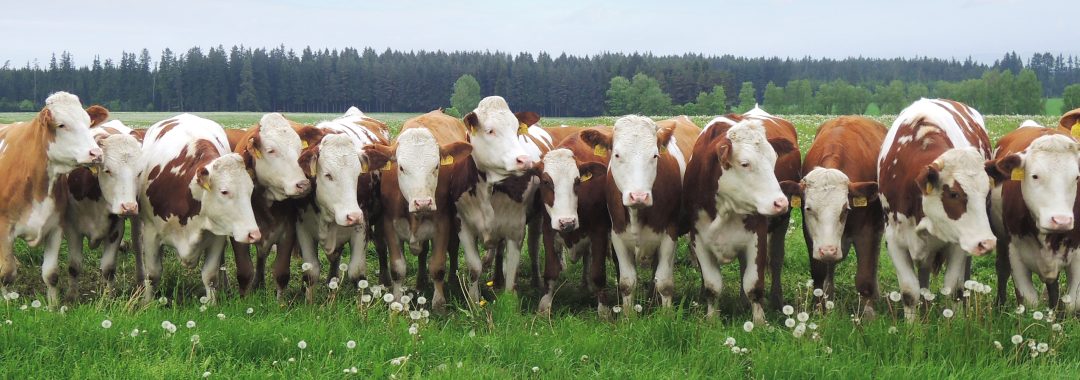The development of a health data recording system and their subsequent analysis contributes to a better understanding of the genetic basis of resistance and enables the identification of genetic markers associated with resistance to specific diseases. Last December, the five-year project under the National Agency for Agricultural Research entitled "Research of dairy cattle breeding methods with the goal to improve disease resistance using genomic approach, systemic health data collecting and targeted genotyping" was completed. In January of this year, the project was successfully defended before the Assessment Board consisting of representatives of the Ministry of Agriculture of the Czech Republic and veterinary professionals.
Current dairy cows can be seen as comparable to elite athletes. However, unlike athletes, their performance, i.e. an average daily production of 38 kg (up to 60 kg of milk in the short term), is required consistently every day, regardless of holidays, vacations, or inclement weather. Such milk production implies a highly intensive metabolism and places a significant burden on the body. For such levels of production, it is essential to meet the needs of dairy cows, particularly by providing them with a nutrient-rich, high-quality feed ration, and ensuring maximum comfort in their housing conditions. If these needs are not met, today's high-producing animals face an increased risk of developing various metabolic, infectious, and organ disorders, including reproductive impairment. In addition to the ongoing efforts of breeders to meet all the needs of dairy cows - aimed at preventing the occurrence of the aforementioned health disorders and ensuring excellent performance and reproduction - another approach to disease prevention is to enhance their resistance. This can be achieved either directly, e.g. by vaccination, or indirectly by supporting immune system functions, or in the long term by breeding animals for increased resistance to specific diseases and overall robustness. In addition to standard breeding practices based on the traits of individuals and their offspring, which, especially in cattle with a relatively long generation interval, are a "long-distance run", this century has witnessed the development of significantly faster breeding methods across the world using the decoded genetic information of individual animals.
The above mentioned five-year project was aimed at achieving this goal. The starting point was the validation and subsequent application of a high throughput DNA extraction method in dairy cattle from a preselected source, which was hair bulbs, followed by routine genotyping of a large number of animals. In addition, new knowledge has been gained on the use of chips that map single-point differences in DNA (SNP chips) for the analysis of genetic disorders in cattle. At the same time, the development of tools for recording and sharing data on the health and diseases of dairy cows and the actual recording of these data was underway, because even in the era of genotyping, the phenotype, i.e. the manifested characteristics of the individual, is "paramount", i.e. the most important. A methodology and algorithm have been developed for breeders to compare the disease rates for individual farms involved in health data recording. This data was then used in direct breeding of Holstein cattle for increased resistance to the most important diseases, primarily clinical mastitis and claw disorders.
The successfully completed project yielded more than four times the planned outcomes. In addition to the 18 planned and completed outcomes, 58 other outcomes were achieved, all of which are highly valuable, including peer-reviewed publications, certified methodologies, workshops, and other communications presented at seminars, conferences, and in the professional press. A total of 76 outcomes were submitted, including 13 articles in scientific journals, 11 peer-reviewed communications in the professional press, 1 functional sample, 1 software, 5 certified methodologies, 6 workshops, and 39 other communications.
All achieved applied results, specifically certified methodologies, software and organized workshops, are already being used and will continue to be utilised in dairy cattle herds in the Czech Republic. The breeding methods are already being employed by Holstein breeders to enhance resistance to the aforementioned selected diseases. Furthermore, these practices can similarly serve as a basis for other breeds of dairy cattle. The possibility of electronic recording and sharing of health data in the online system "Diary of Diseases and Treatment " along with other software communicating with it for herd health management, fulfilling registration obligations for the use of medicaments, data transmission for breeding purposes, etc. is now being utilised by several hundred users. The follow-up benchmarking of dairy cow and calf health/disease rate is a completely new tool in the Czech Republic, which is available free of charge to all breeders and is already used mainly by professional services as a motivational tool to reduce dairy cattle morbidity.



